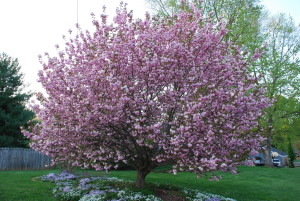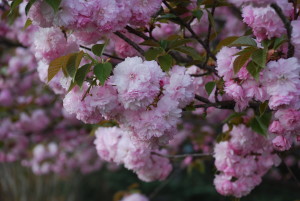Kwanzan cherry (Prunus serrulata ‘Kwanzan’) is a commonly planted Oriental cherry in the U.S. (USDA hardiness zones 5 – 8). It’s most often utilized as a small 25 to 35 foot tall flowering deciduous tree in an open lawn, patio. and deck setting for its cool summer shade. It is a 4-season specimen and should be located where it can be viewed year-round.
Kwanzan cherry is in glorious flower in mid-spring and is frequently planted along with Yoshino Cherry (P. x yedoense) in Washington, D.C. and Macon, Georgia for their annual Cherry Blossom Festivals. Yoshino cherry produces abundant single pale pink cherry blossoms a full week or two before Kwanzan. The later blooming Kwanzan is less prone to late spring frosts, which is so important to festival planners.
The 2-inch diameter powder-puff pink flowers are comprised of 24 – 28 petals, with no sexual floral parts. Therefore tree will rarely produce fruits. Flower clusters of 3-5 blossoms develop at each node. New spring leaves are bronze colored at the start and turn to a medium green within a few days. In autumn leaves turn yellow, orange, or copper colored. A unique way to identify Kwanzan is the pair of large distinctive glands at the base of each leaf blade.
Site selection is very important in growing Kwanzan cherry. It performs best in full sun and in a well-drained fertile soil. Hot, dry summers can shorten a tree’s life span. Annual pruning is absolutely essential and should be performed immediately after flowering. Remove dead, weak, or sickly branches, including those that may be infested with scales and other serious insect pests.
Kwanzan cherries are prone to a long list of insect and disease problems, including cankers, black knot, leaf spot, die back, leaf curl, powdery mildew, root rot and fireblight. Potential insects include aphids, scales, borers, leaf hoppers, caterpillars, tent caterpillars, Japanese beetles and spider mites. Canker, borers and virus can be particularly troublesome under high stress environmental conditions such as hot droughty sites.



 Posted in
Posted in 
